The CalDigit T3 Thunderbolt Array Provides Fast and Flexible Storage in a Quiet Package
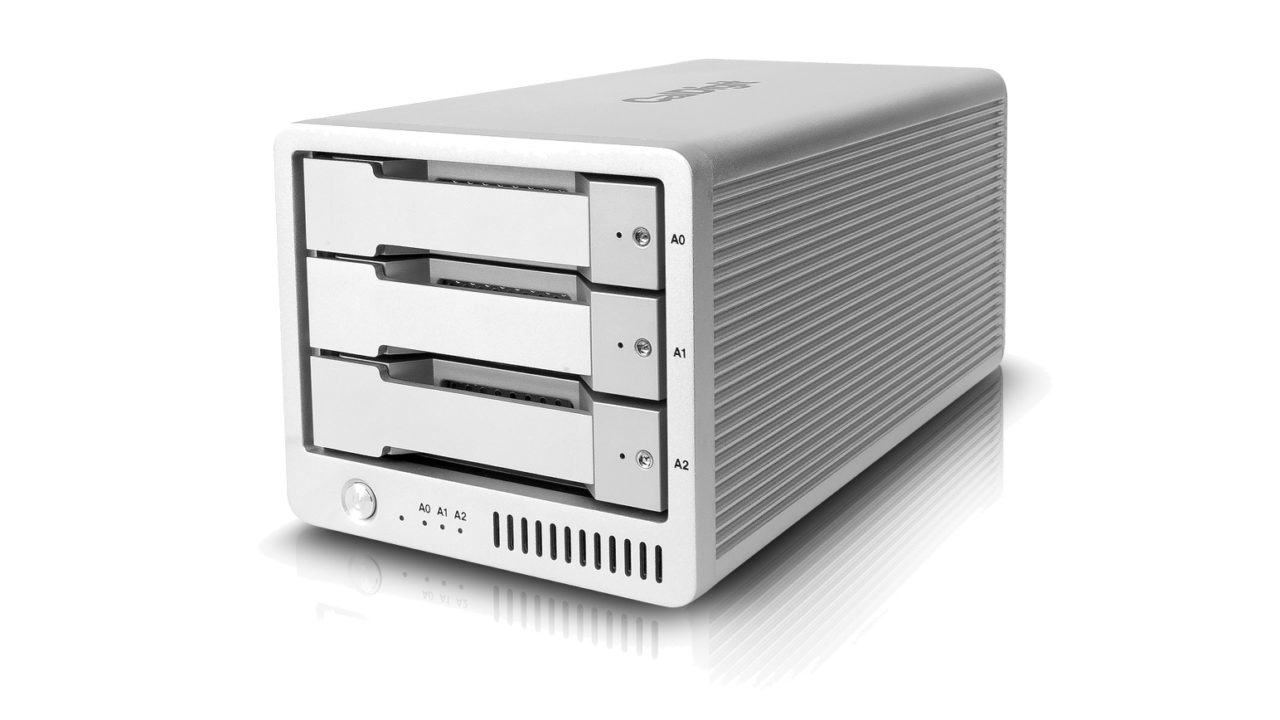
Storage firm CalDigit may have been relatively late to the Thunderbolt market, but they’re making up ground fast with several very interesting Thunderbolt-based solutions. After giving the company’s Thunderbolt Station dock high marks late last year, we were eager to try out their latest Thunderbolt storage array, the CalDigit T3.
Update [2014-11-10]: CalDigit has released an updated T3 with support for Thunderbolt 2 and 4K display chaining. Check out the new benchmarks and overview.
Box Contents and Design
The CalDigit T3 comes neatly packaged in a cardboard box along with an external power adapter, 5-foot power cord, and two security keys for the drive bays, including one to lock the bay and another pin key to pop it open when unlocked.
Gigabyte-for-gigabyte, you’ll pay a little bit more for the T3, but you’ll get better performance or More flexibility depending on your desired configuration.
From a design perspective, consumers will immediately notice that the T3 sports an unusual configuration: three drive bays. We were at first intrigued by the decision to release a three-bay option into a market filled primarily with two- and four-bay arrays. But after using the drive for a few weeks, the value became clear. The T3 gives users the benefit of an extra drive in about the same footprint and price point as a two-bay model, providing either faster overall performance (via RAID 0), extra data security (via RAID 1), or greater flexibility (via a combination of RAID and a standalone passthrough drive). Even better, with the upcoming release of SoftRAID 5, users will be able to optionally configure the T3 as RAID 5, providing a mix of performance, capacity, and security, something that’s not possible with just two drives.
The T3 is offered in a variety of drive configurations, including options that mix and match solid state and mechanical hard drives. Our test unit contains three 2TB hard drives, providing a maximum capacity of 6TB in RAID 0. Specifically, our unit contained three Toshiba DT01ACA200 7200RPM drives.
To ensure performance and compatibility, CalDigit limits user access to drive replacements. Users can still manually replace the included drives with almost any 3.5-inch or 2.5-inch HDD or SSD, but doing so will void the T3’s warranty. To keep things official, users in need of replacements will have to buy complete “drive modules,” which are HDDs or SSDs pre-installed into compatible drive trays. While the type of drive you receive in your own T3 may vary from ours, this restriction results in quite a large markup in the case of our 2TB Toshiba drives. A 2TB Drive Module from CalDigit costs $179 (although you get a drive tray and $10 Archive Box included in that price), while the same bare Toshiba drive model currently costs about $90. We certainly appreciate the need for compatibility and quality control, but that’s a hefty margin if you ever need to replace or purchase a spare drive.
On the plus side, CalDigit has unified the drive module format across its current and future product lines, meaning that you can swap drive modules between the T3, the single-drive AV Pro, and any future storage products the company releases.
While drive replacements may be expensive, the build quality of the unit is excellent. Like CalDigit’s other recent products, the T3 is crafted in beautiful aluminum with clean lines and smooth edges. Just like an Apple product, CalDigit seems to have considered everything when it comes to design.
The three drive trays slide into the front of the unit and are secured into place with levers that can then be locked with the included key. An air intake on the bottom of the unit’s face works in conjunction with the smart fan on the rear to regulate temperatures under heavy loads.
A single power button on the front turns the T3 on and off, and individual blue LEDs report activity for each of the three drives.
On the back, users will find two Thunderbolt ports, allowing for passthrough in a Thunderbolt chain. Note, however, that the CalDigit T3 is a first-generation Thunderbolt device. While compatible with the new Thunderbolt 2 specification, it will only operate at first-generation 10Gb/s speeds. Therefore, if you’re using the T3 with a Thunderbolt 2 workflow, make sure that it’s positioned at the end of your Thunderbolt chain, so as to avoid slowing down other Thunderbolt 2 devices. Practically speaking, however, only those buying T3s with three SSDs will likely notice the absence of Thunderbolt 2; a three-HDD configuration doesn’t reach the 10Gb/s limit.
Also on the back is the power connection and a Kensington security lock. When used alongside the drive module lock, users can ensure that only the most dedicated thieves will be able to make off with the unit and its data.
The entire CalDigit T3 sits on four rubber feet that keep it from sliding around on the desk and help prevent drive vibrations from transferring.
Overall, the unit measures 4.5 inches tall, 5.3 inches wide, and 9.5 inches deep, with a weight of just under 10 pounds for the hard drive model (the SSD models share the same dimensions but weigh only about 6 pounds).
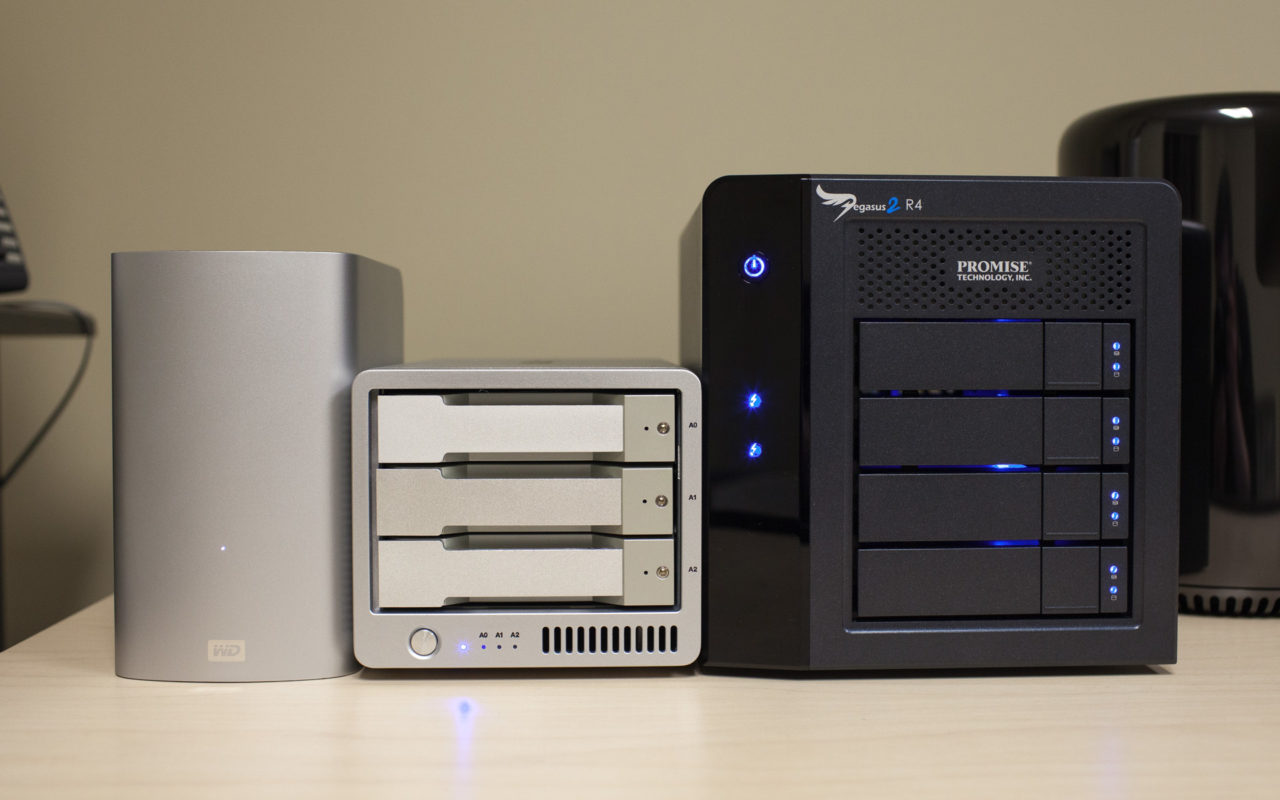
The CalDigit T3 sitting between a Western Digital MyBook Thunderbolt Duo (left) and a Promise Pegasus2 R4 (right).
From a heat and noise perspective, the T3 excels. The unit’s smart fan kicks in only when necessary, and operates at a maximum noise level of 17 dBA. This translates into a soft, even sound that is only noticeable when you’re intentionally listening for it. Sitting on our desk alongside a Western Digital MyBook Thunderbolt Duo, a Promise Pegasus2 R4, and a 2013 Mac Pro, the CalDigit T3 fits right in and generates only minor noise.
The same goes for thermals. The smart fan and aluminum design keeps the whole unit cool, even after an hour-long read and write test. The top of the unit warms up only slightly during heavy workloads, while the sides remain cool to the touch. It’s a remarkably good design considering it contains three full-sized hard drives going full tilt for more than an hour straight. Those opting for SSD configurations will likely see even better results in terms of heat and noise.
Setup
The CalDigit T3 ships configured for RAID 0, which provides the fastest speeds but also the least amount of data security. It uses software RAID for configuration, and users can easily modify their setup using OS X’s Disk Utility. Unfortunately, because the T3 lacks a hardware RAID controller, options for setup are limited. Disk Utility currently only supports RAID 1 (mirroring), RAID 0 (striping), and JBOD (concatenated) configurations. A more advanced configuration like RAID 5 is only available via hardware RAID controllers, although upcoming software from SoftRAID promises to bring software-enabled RAID 5 to OS X soon.
CalDigit suggests that users can take advantage of this limitation by thinking about the T3 not only as a three-drive array, but also as a two-drive array with an extra disk thrown in. This would allow users to have a RAID 1 mirror on drives one and two, for example, but a hot spare drive in bay three in the event of a failure. Users could also configure separate volumes, and have a RAID 0 scratch disk with drives one and two, and an extra disk for backups in drive three.
The ability to mix and match solid state and mechanical hard drives also plays into the mix. Thanks to Thunderbolt, users can boot to the T3’s volumes, allowing for an SSD boot volume in bay one, and a RAID configuration in bays two and three. The possibilities are numerous.
Still, the presence of a hardware RAID controller, such as those found on the Promise Pegasus line, would have enabled all of these scenarios as well, plus the option for RAID 5 out of the box. It would also mitigate the slight performance hit that software RAID experiences compared to modern hardware RAID controllers.
Once you’ve figured out your desired configuration, there’s no further setup. The volume(s) on the CalDigit T3 will mount to your desktop and will be ready to go without the need for additional drivers or software.
Benchmarks
Depending on your configuration, the extra drive afforded by the CalDigit T3 compared to similarly priced two-bay arrays can give users a nice boost in performance. We measured random and sequential performance in both RAID 0 and RAID 1 configurations, and the results are quite good for a hard drive-based product.
RAID 0 is where users will see the greatest performance, although it should be noted that users must maintain robust backups of their data as the failure of any one of the three drives will result in the loss of all data.
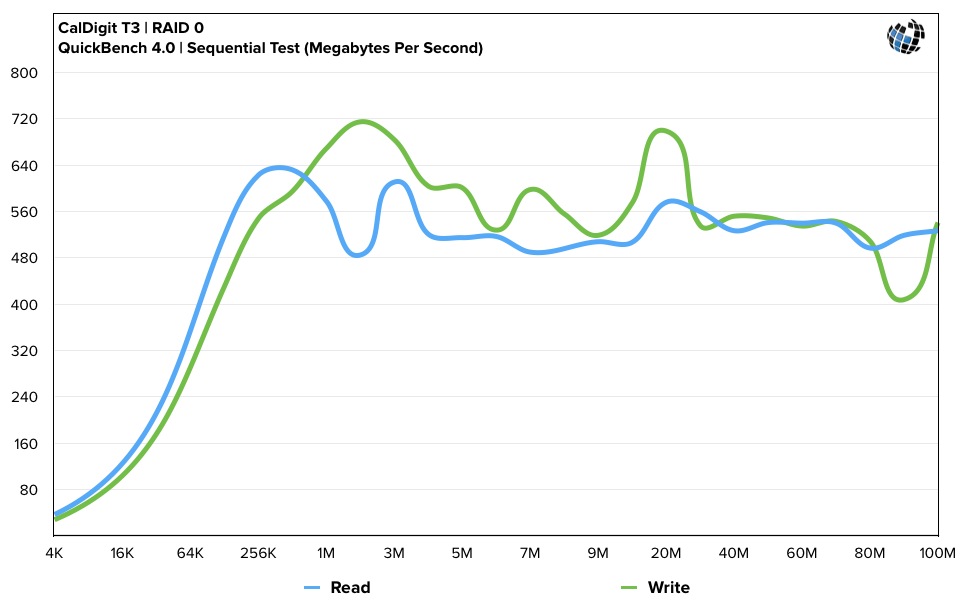
Here we see very good performance, with reads averaging out at around 560MB/s and writes at nearly 600MB/s. Peak performance tops out at about 640MB/s for reads and 720MB/s for writes. In terms of pure performance, this gets easily beaten by SSD-based Thunderbolt 2 products but, for the price and capacity of the T3, most professionals will be happy with these numbers.
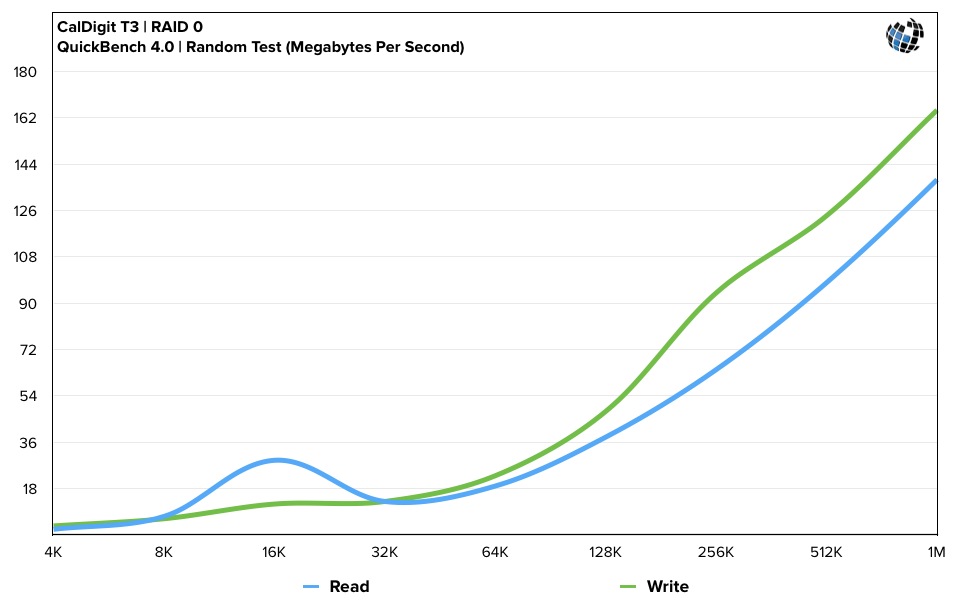
Random performance is also very good for the hardware. Writes peak at about 160MB/s with reads at around 140MB/s for large transfer sizes. As with most random operations, you’ll see slower speeds with smaller files, but you’d need to move to a much more expensive SSD-based solution to really make improvements there.
In terms of extra data security, we also configured the unit as RAID 1. This provides three copies of your data with 2TB of overall capacity, ensuring that important information is relatively safe. The downside, however, is that in addition to the decreased usable capacity, write performance also takes a hit.
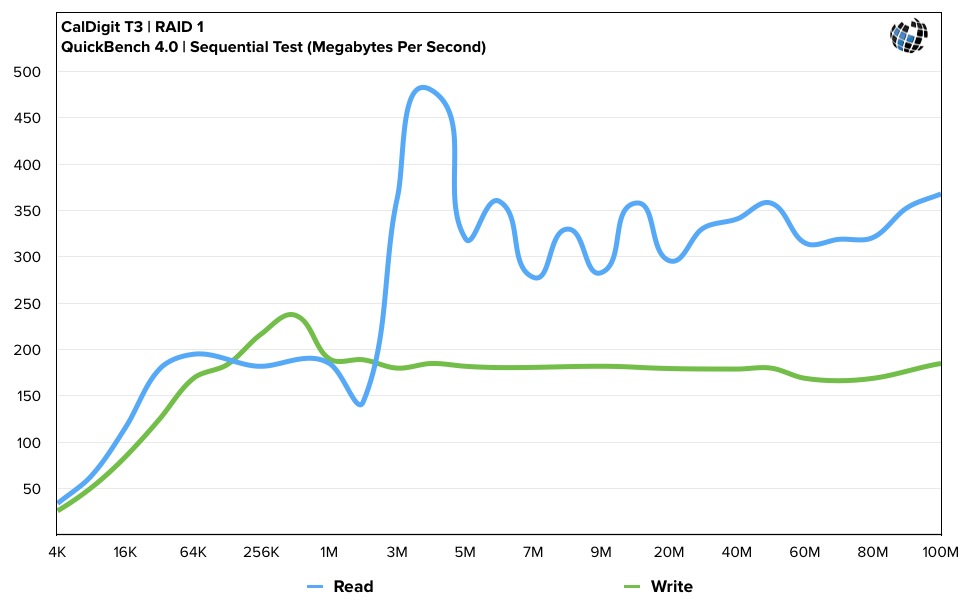
Sequential reads peak at about 475MB/s but settle down into the the 300 to 350MB/s range whereas writes average out around 170MB/s. These are still respectable numbers for a three-drive HDD RAID 1 configuration.
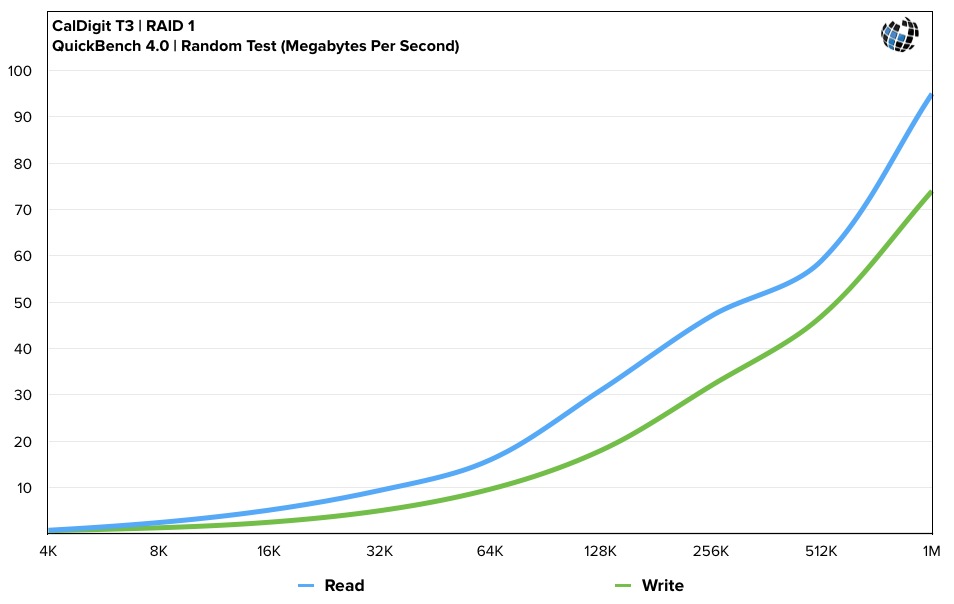
Random operations tell the same story, peaking at around 90MB/s reads and 70MB/s writes for large transfer sizes.
Looking briefly at power consumption, your numbers may vary due to the drive configuration, but we registered 23 watts at idle and just under 30 watts during heavy workloads. When powered down, the T3 draws about 0.5 watts at the wall.
Value
Thunderbolt products are expensive, plain and simple. But the technology is often the best choice for professionals who need the most performance and flexibility. With that in mind, the price of the CalDigit T3 seems high, but it’s necessary to compare it to other Thunderbolt options to truly gauge its value.
Our 6GB HDD test unit has a retail price of $749. Below is a chart with the complete lineup and prices.
| HDDs | SSDs | Price |
| 3 x 1TB | N/A | $449 |
| 3 x 2TB | N/A | $749 |
| 3 x 3TB | N/A | $899 |
| 3 x 4TB | N/A | $1199 |
| 2 x 2TB | 1 x 960GB | $1399 |
| 2 x 3TB | 1 x 960GB | $1599 |
| 2 x 4TB | 1 x 960GB | $1799 |
| 1 x 2TB | 2 x 960GB | $1999 |
| 1 x 3TB | 2 x 960GB | $2199 |
| 1 x 4TB | 2 x 960GB | $2399 |
| N/A | 3 x 960GB | $2799 |
While the lower-end models are reasonably priced, you can see that costs quickly escalate as more SSDs are added to the mix. But looking at other competing products places the T3’s price in the correct perspective. The 4TB 2x2TB Western Digital MyBook Thunderbolt Duo, for example, retails for about $500, while the 6TB 2x3TB model runs about $690. Both of these options will be slower in RAID 0 configurations due to the extra speed afforded by the T3’s third drive.
If you need more than 12TB, regardless of performance, you’ll have to go with one of the four- or five-bay options.
From LaCie, you can get the 2-drive “2big” series in 4TB ($499), 6TB ($629), 8TB ($799), and 10TB ($899) capacities. Although not directly comparable in capacity, these LaCie drives again will be slower than the CalDigit T3 in terms of RAID (assuming similar hard drive specifications).
Where the CalDigit T3 starts to look expensive is when you compare it to larger four- and five-bay products. Turning to LaCie again, they offer a 10GB “5big” model for $999. Promise offers the Thunderbolt 2-enabled 8TB Pegasus2 R4 for $1499. Both options give the user more capacity and more flexibility than the T3. The Pegasus2 also features hardware RAID, allowing for more sophisticated RAID configurations.
And so we’re left with the CalDigit T3 occupying this heretofore unaddressed market segment: users who want a bit more performance than the 2-bay Thunderbolt arrays without stepping up to the generally larger 4- and 5-bay options. When compared to the the two-bay options, discussed above, the question comes down to speed and flexibility. If you’re looking for total capacity at the lowest price, you’re better off going with a two-bay option with two larger drives, such as the 6TB MyBook Thunderbolt Duo for $690 compared to our 6TB CalDigit T3 review unit for $749.
But if you’re willing to spend just a little bit more ($59 in this case) you’ll get the benefit of that third drive, which can be configured as a spare or used in RAID to speed up the overall performance of the array. This only takes you so far, however. The three-drive limit and the current capacity of hard drives means you max out at 12TB (RAID 0) with the T3. If you need more than that, regardless of performance, you’ll have to go with one of the four- or five-bay options.
Conclusions
With the above performance calculation in mind, the CalDigit T3 is a very compelling product for users looking for 12TB or less of Thunderbolt storage. Gigabyte-for-gigabyte, you’ll pay a little bit more for the T3, but you’ll get better performance or more flexibility depending on your desired configuration.
The overpriced drive replacements are disappointing, however, and we don’t like that you can’t use your own drives without voiding the warranty. Thunderbolt arrays are still firmly in the realm of professionals and prosumers, so we understand that companies want to ensure mission critical reliability, but limiting user choice is never good in our book, and we hope that CalDigit revisits this policy in the future. We also wish that a Thunderbolt cable was included in the box, but this is a common omission by most manufacturers, so we can’t be too upset at CalDigit on this point.
If you’re okay with the drive replacement restrictions, however, our experience with the T3 was otherwise overwhelmingly positive. Considering its strong performance, outstanding build quality, quiet noise levels, good thermals, and, in our opinion, great looks, the CalDigit T3 should definitely be on your list when shopping for Thunderbolt storage.
The CalDigit T3 is available now from the CalDigit online store and via third party retailers like Amazon. As shown in the above table, there are a variety of configurations to choose from, ranging in price from $449 to $2,799. All models come with a one-year limited warranty.




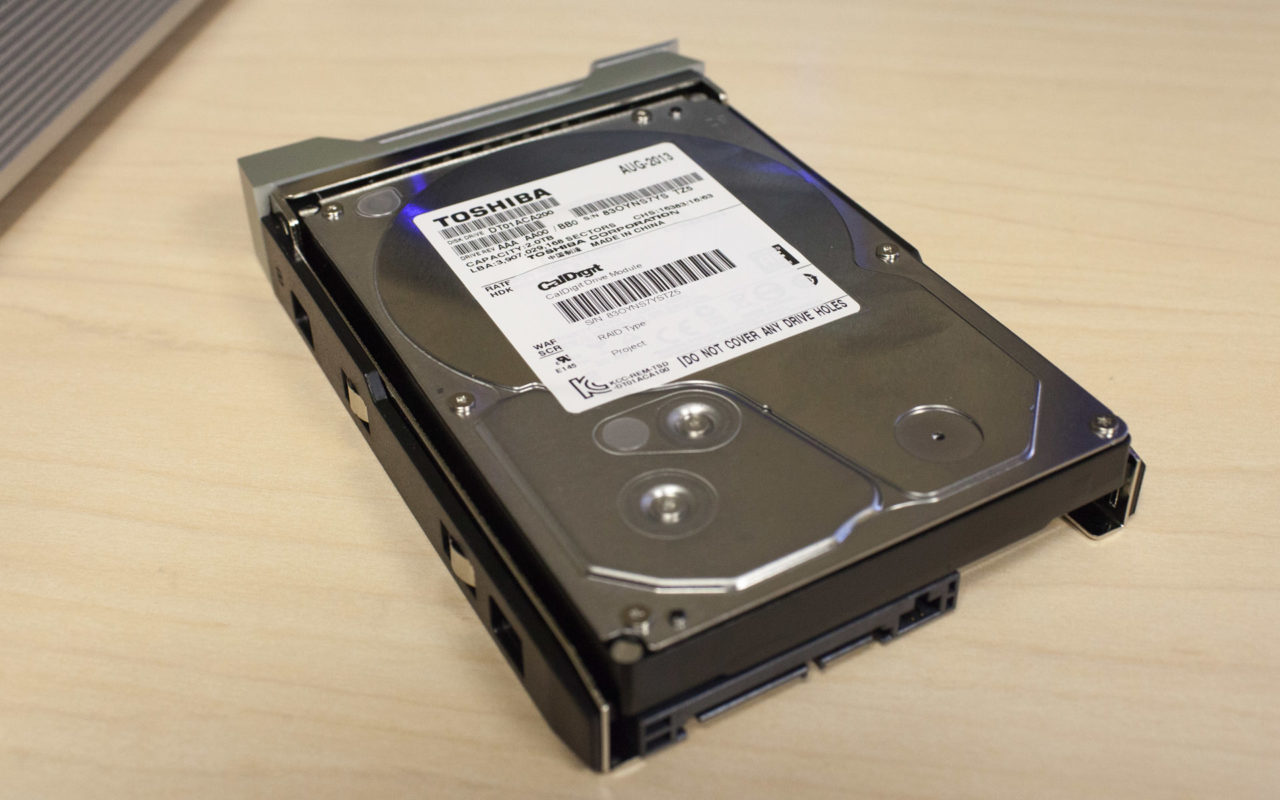
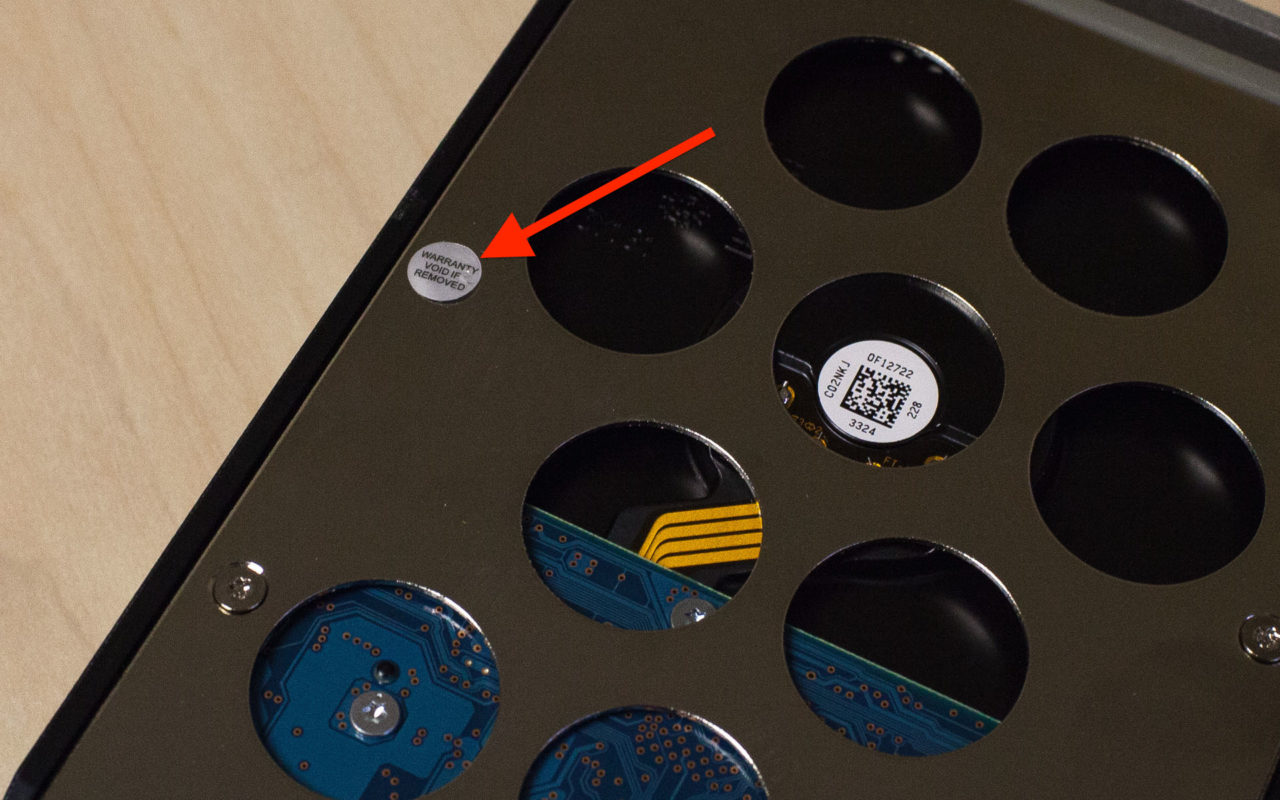
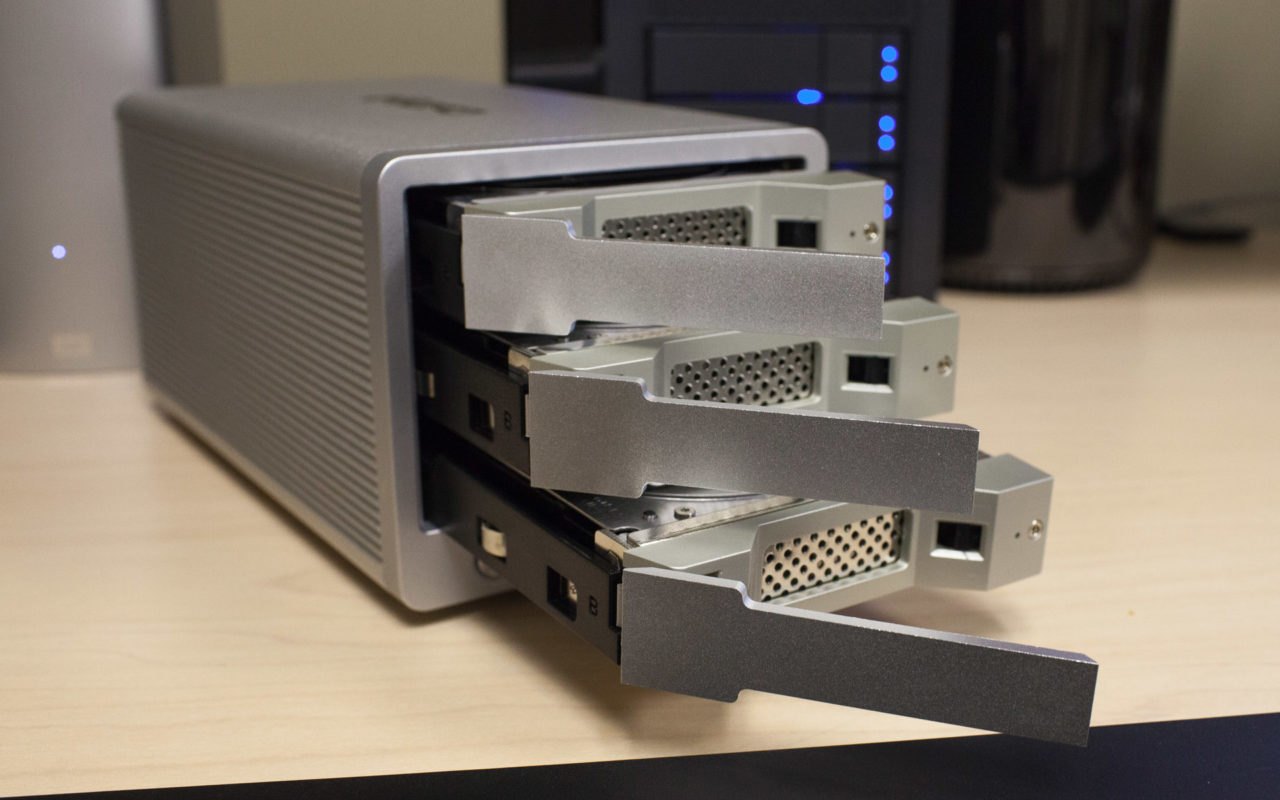
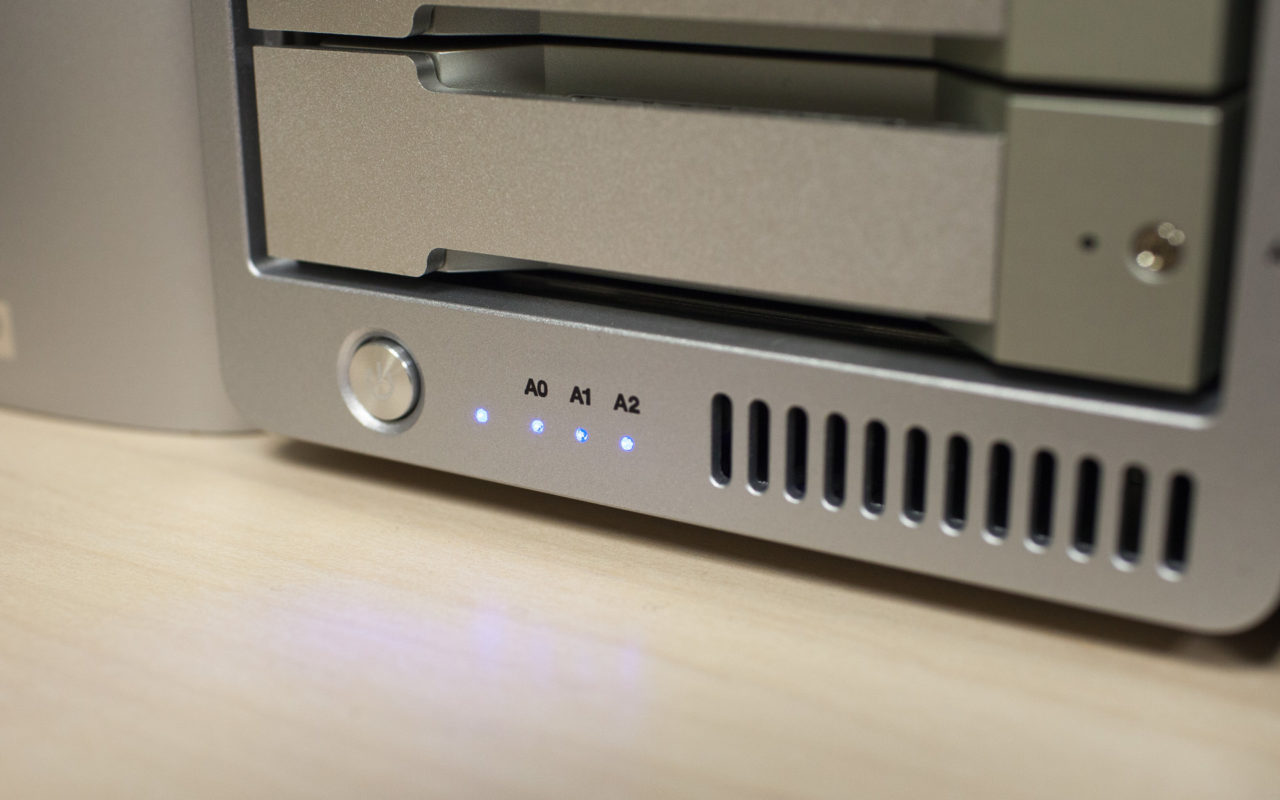
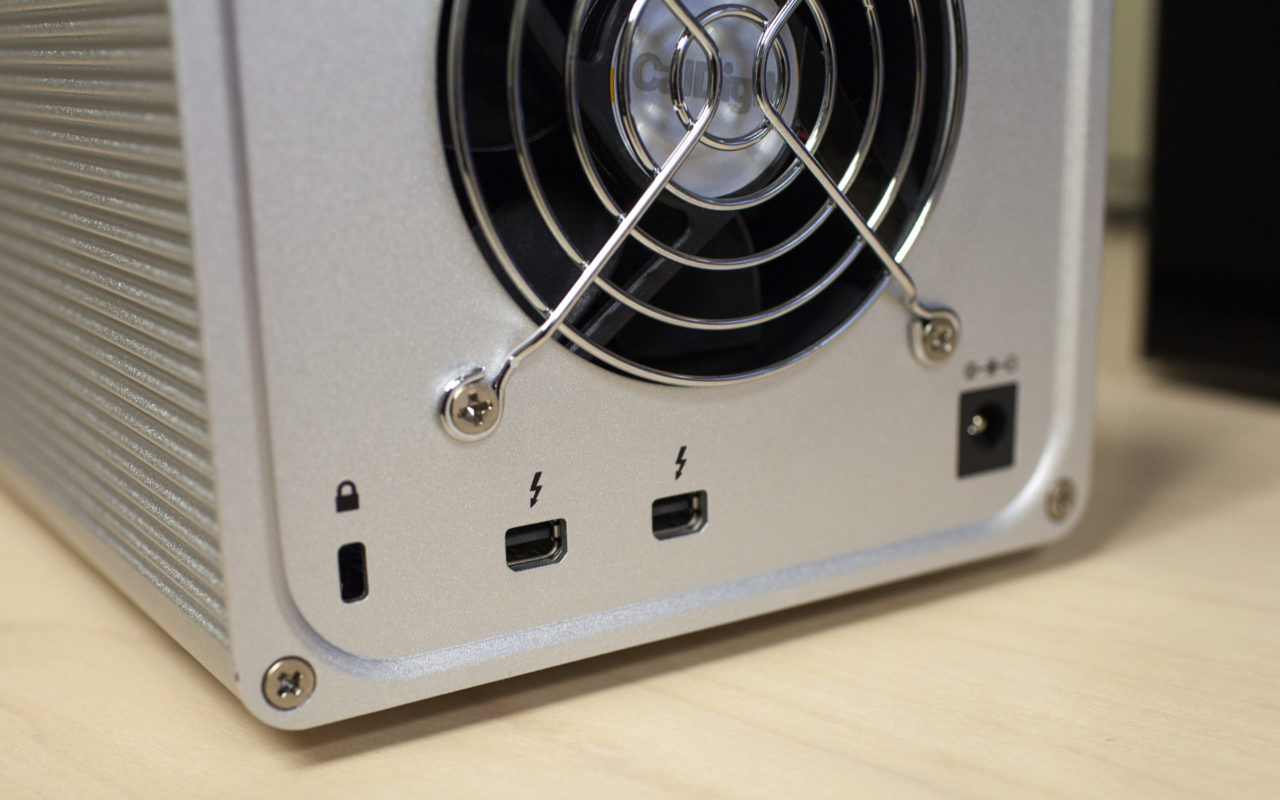

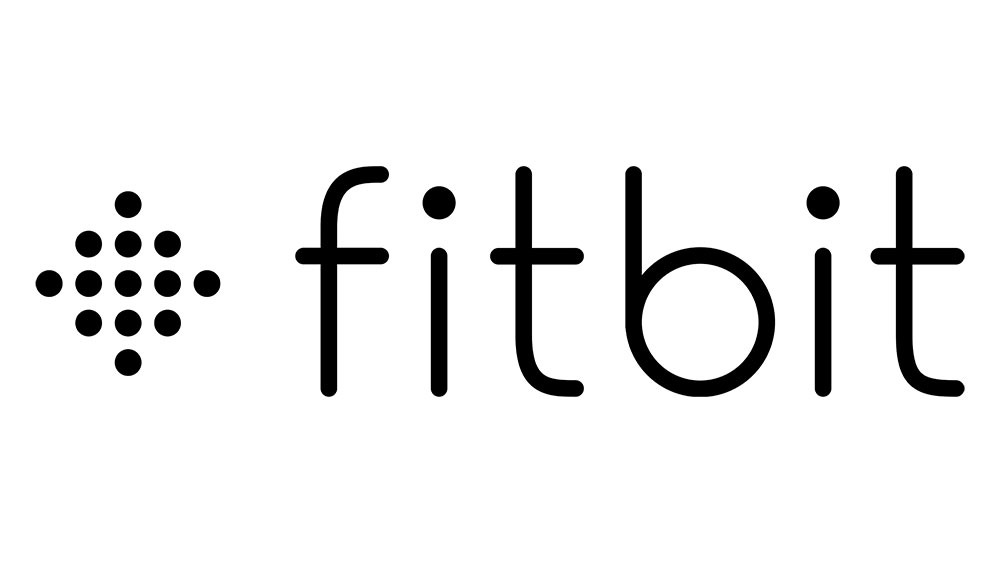



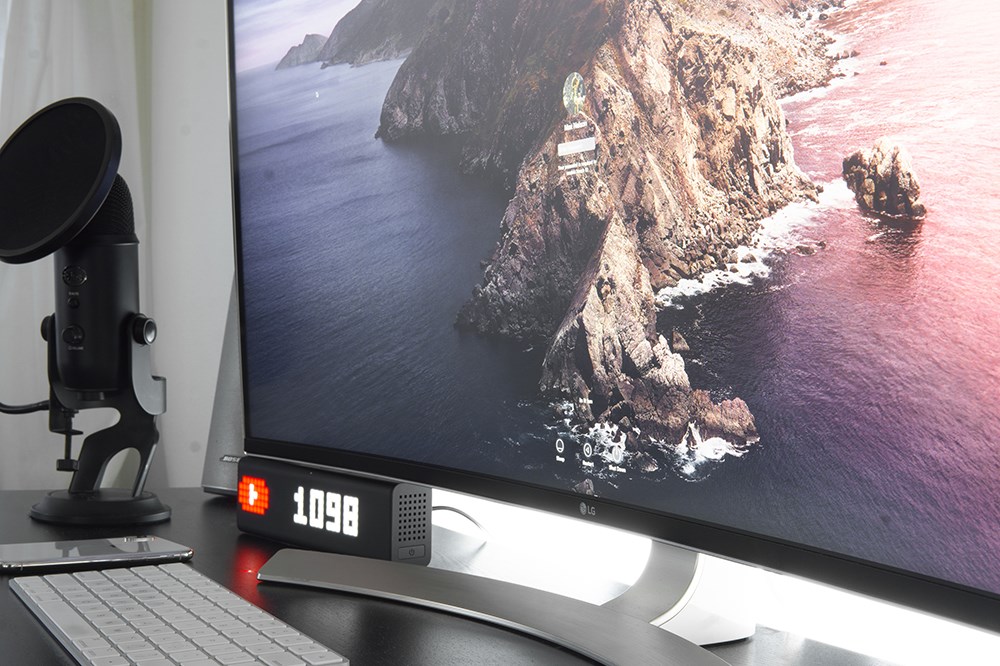








One thought on “The CalDigit T3 Thunderbolt Array Provides Fast and Flexible Storage in a Quiet Package”
While I agree that it would be nice to see this product with Thunderbolt 2, I disagree with your comments about RAID. Larger RAID arrays are indeed more capable (RAID 6 with 12 drives is my variety of choice), but two and three drive RAID configurations are still useful. RAID 0, as long as you accept the data loss risk, is great for speeding up a scratch volume while RAID 1 with two or even three drives is useful for working with important data (although you’d still want an offsite backup, too). This particular array isn’t perfect for everything (like storing huge video libraries), but we had great success during our review using it a RAID 0 scratch and work disk (muxing video and audio, raw audio recordings, etc).
Thanks for visiting!